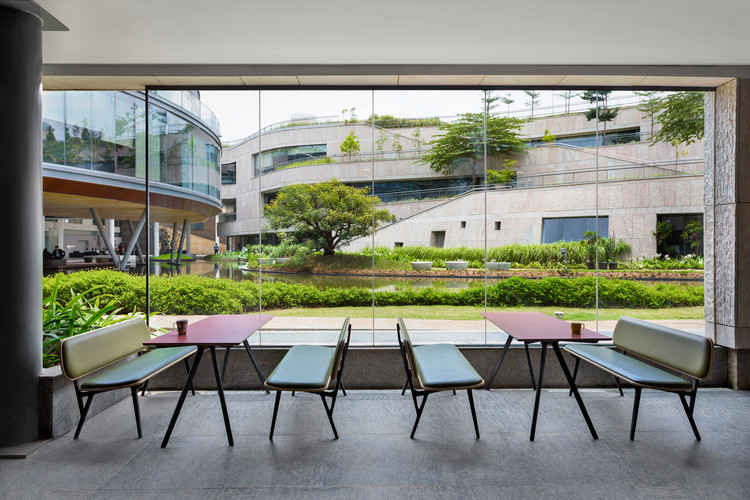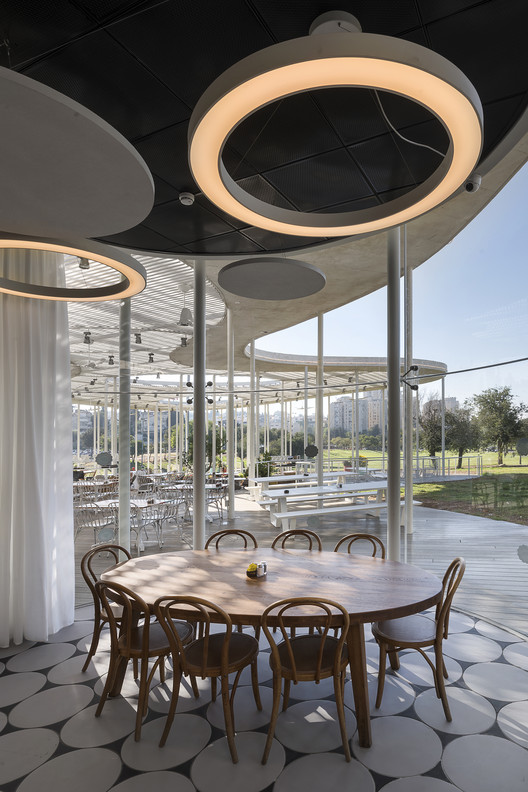Deep Dive Rowing Club Scenic Architecture Office
2018-07-14 22:00
© Schran Studio
C.Schran Studio


架构师提供的文本描述。为了长期促进和支持中国赛艇运动,万科教育集团与上海浦东新区合作,计划在世纪公园建立一个小型划艇俱乐部,为更多的青年和青少年组织划艇训练和活动。俱乐部每年有200名学员,每个月有20至30名学员,俱乐部需要储存大约15-20艘划艇,并提供培训。
Text description provided by the architects. In order to promote and support China's rowing sport for a long term, Vanke Education Group, in collaboration with Shanghai Pudong New District, planned to build a small rowing club in Century Park to organize rowing training and activities for more youth and teenagers. Having 200 trainees each year with 20 to 30 every month, the club needs to store approximately 15-20 rowing boats and provide training & activity rooms, lockers & showers, toilets and seating areas for adolescents. The club will conduct daily training and technical instruction and also open to parents and rowing enthusiasts.
© Schran Studio
C.Schran Studio


世纪公园是上海市区最大的向公众开放的湿地公园。张家板江是一条横跨公园,宽约35米的城市河流,可部分用于赛艇训练。赛艇运动员在划船时面临着前进的相反方向。出于安全和速度变化的考虑,我们在河湾的拐弯处设立了俱乐部,以方便双程往返。
Century Park is the largest wetland park open to the public in downtown Shanghai. The Zhangjiabang River, which can be partially used for rowing training, is an urban river that crosses the park in a rough width of 35m. Rowing athletes face the opposite direction of advancing when paddling. Due to the considerations of safety and speed change, we set up the club at the bend point of the river with a cove to facilitate two-way departures and arrivals.
Site plan. Image
现场计划。影象


这片土地上覆盖着密密麻麻的美洲红杉森林,仅留下一个4米宽的码头在岸上。为了尽量减少对原有环境的影响,我们将可用空间分为四个部分:码头位于海湾南侧,活动室设在河西,更衣室建在旧码头上。船屋是该项目中唯一需要占用现有森林的部分。为了避免大规模砍伐或移栽,我们将船屋分成三条薄片分散在森林中,大致与新码头的方向相对应。
The site was covered with densely planted metasequoia forest, leaving only a 4-meter-wide old pier on the shore. In order to minimize the impact on the original environment, we divided usable spaces into four parts: the pier is located on the south side of the cove, the activity room is placed on the west side of the river, and the changing room is built on the old pier site. The boathouse is then the only part of the project that needs to occupy the existing forest. To avoid large-scale felling or transplanting, we split the boathouse into three thin strips scattering in the forest, roughly corresponding to the direction of the new pier.
© Schran Studio
C.Schran Studio


划艇有单打、双打、四、八四种大小。长度约8~18m,宽度仅30~60 cm。我们为船只设计的“小家”的宽度仅限于容纳一艘船,但只有四层楼,长度是船长模块的组合。为了减少公园现场施工的影响,船屋的结构基础由预制的点状混凝土砌块组成。柱由两个螺栓角钢组成,在上部像一棵树的叉子,形成一个“Y”来支撑双倾斜的树冠。在下面的第四部分这些纤细的船屋是完全开放的,只有必要的屋顶遮蔽处,这使得载着沉重重量的船在森林里行走。
The rowing boats have 4 kinds in size for singles, doubles, fours and eights. The length is about 8-18m and the width is only 30-60cm. The width of the “small home” we designed for the boats is limited to accommodate only one boat yet with four floors, and the length is a combination of the boat length modules. In order to reduce the impact of on-site construction in the park, the structural foundations of the boathouses consist of prefabricated point-like concrete blocks. The column composed by two bolted angle steel, is forked in the upper part like a tree to form a “Y” to support double pitched canopy. On the lower part four “branches” cantilevered from the column serve the rowing boat storage. The slender boathouses are completely open with only necessary roof shelter, making the boat carrying a weight-bearing walk in the forest.
© Schran Studio
C.Schran Studio


为了减少移栽,我们测量并记录了每种水杉在该地点的位置,以便从适当的角度将这三个船坞插入到森林中。然而,仍然很难将它们放在现场。幸运的是,阳光投射在森林中的阴影给了我们慷慨的帮助。沿着阴影,我们就可以调整角度,找到更多的空间。
To reduce transplanting, we measured and recorded the position of each Metasequoia in the site so that the three boathouses could be inserted into the forest from suitable angles. However, it is still difficult to position them on site. Fortunately, the sunlight casting shadows in the forest gave us generous help. Along the shadows were we then able to adjust the angles and find more spaces.
© Schran Studio
C.Schran Studio


更衣室建在原来的码头上,是一个狭窄的酒吧,由邦基拉伊面板包围。屋顶由折叠钢板制成,由山墙形状的梁支撑,天窗将自然光带入储物柜和淋浴间。我们希望更衣室的坚固性不仅能满足自己对隐私的需求,还能帮助我们成为船屋森林与活动室所在河流之间的一道屏障,从而将这两个地方的纯粹体验结合起来。
The changing room built on the original pier is a narrow bar enclosed by Bangkirai panels. The roof is made by folded steel plates supported by gable-shape beams, with skylights bringing natural light into lockers and showers. We hope that the solidity of the changing room will not only satisfy its own need for privacy, but also help us as a barrier between the forest for boathouses and the river where the activity room was located, hence to enclose the pure experiences of these two places.
© Schran Studio
C.Schran Studio


这条河上的活动室是一个滨水亭,就像“不系船”一样。底座为驳船状矩形钢格栅,压入河床的管桩上.盖子是一个20米长的双斜屋顶,两端只有双H型钢支柱支撑,这给了自由和进入空间的机会:H柱之间是通向外部平台的门,柱子上的双横梁成为天窗的通道。
The activity room in the river is a waterfront pavilion like “a boat not tied”. The bottom is barge-like rectangular steel grating on pipe piles driven into the riverbed. The cover is a 20-meter-long double-pitched roof, supported only by twin steel H-pillars at both ends - this gives freedom and access to the space: between the H-pillars is the door towards exterior platforms, between the twin beams on the pillars becomes the passage for the skylight.
© Schran Studio
C.Schran Studio


Section. Image
部分。影象


© Schran Studio
C.Schran Studio


活动室的东侧与更衣室相邻。一个8米长的橱柜把这两个空间隔开,前面是储藏室,后面是一个书写板,两端都有空调。活动室的另外三面向河岸;在西侧,三套可折叠的滑动窗提供了完全的对外开放。
The east side of the activity room is adjacent to the changing room. An eight-meter-long cabinet divides these two spaces, the front is for storage, the rear is a writing board, and the two ends contain the air-conditioners. The other three sides of the activity room are facing the riverfront; on west side three sets of foldable sliding windows provide complete openness to the outside.
© Schran Studio
C.Schran Studio


在滑动的窗户下面是一个长而宽的木制窗台,可以坐下来,使这个边界空间成为休息、交流和观看的地方。它还建立了室内测力仪训练与河中划艇训练之间的视觉联系。我们不仅允许展馆对周围的环境开放,而且通过它在水中的位置给予它一个特殊的特性,并且与河岸相比,它的楼层海拔略低一些。要进入展馆,需要从入口下来三步,直到你把自己安置在这个平静的空间里,你才开始感觉到与外界自然的融合。
Below the sliding windows is a long and wide wooden sill that can be seated, making this boundary space a place for rest, communication, and viewing. It also established a visual connection between indoor ergometer training and rowing training in the river. We not only allow the pavilion to open itself to the surroundings, but also give it a special identity through its position in the water and a slightly lower floor elevation in comparison with the riverbank. To enter the pavilion requires three steps down from the entrance, it is yet until placing yourself inside this calm space that you start to perceive the merge with the nature outside.
© Schran Studio
C.Schran Studio


桥墩位于河与海湾之间的边界处,位于基座的南侧。桥墩漂浮在水中,通过抱抱滑轮将其固定在管桩上。它被塑料板覆盖,并由一捆浮标支撑。码头服务于两岸,通过5.5米宽的坡道连接到船屋区域,并通过一个小梯子连接到活动室和更衣室之间的通道。坡道和梯子都有铰链连接,以适应水位的波动。
The pier is located at the boundary between the river and the cove on the south side of the base. The pier floats in the water and is fixed with pipe piles by embracing pulleys. It is covered with plastic wood panels and supported by bundles of buoys. Serving both sides, the pier connects to the shore through a 5.5-meter-wide ramp to the boathouse area, and to the passage between the activity room and the changing room through a small ladder. Both the ramp and the ladder are connected by hinges to comply with the fluctuation of the water level.
© Schran Studio
C.Schran Studio


码头、船屋、更衣室和活动室是俱乐部需要的四个独立场地。我们设计了一套方便和逻辑的循环,可以将它们有机地联系起来。从公园路进入,沿着一条小路进入森林,你会在俱乐部入口处遇到一个岔路口。
Pier, boathouses, changing room, and activity room are four independent venues that the club requires. We designed a set of convenient and logical circulation that can link them in an organic way. Entering from the park road, following a path into the forest, you will encounter a fork near the entrance to the club.
Floor plan. Image
平面图。影象


左转,你将继续走在林间的车道上,以运送船只。右转你可以穿过森林到达入口,这是一个由更衣室半封闭的庭院,延伸的木板墙和一棵巨大的柳树。左边的小路分散到森林中的船屋,然后又聚集在岸上,通过坡道到达码头;右边的小路进入大楼,成为更衣室和活动空间之间的一条通道。当它昏倒时,它也通过梯子到达码头。在这一点上,这两条路再次合并在码头上。
Turn left you will continue walking through the forest on the lane for transporting the boats. Turn right you can cross the forest and arrive at the entrance, which is a courtyard semi-enclosed by the changing room, the extension of a wooden panel wall and a large willow tree. The left path was dispersed to the boathouses in the forest, then gathered again on the shore and reached the pier through the ramp; the path on the right enters the building and become a passage between the changing room and the activity space. When passing out, it arrived pier as well through the ladder. At this point, these two paths were merged again on the pier.
© Schran Studio
C.Schran Studio


在这个循环系统中,我们特别注意室外区域。除了高大的梅花树外,还有丰富的灌木、花卉、植被和小动物,如松鼠和海龟,它们经常在森林和河岸之间移动。为了减少对环境的干扰,我们只在通往建筑物入口处的道路上铺木板,而在区建造透水通道。沿着小路,我们排列了600个混凝土小块,作为单独的点,不锈钢烤架作为小径放置在这些小块上。这些透明的人行道仍然允许植物在它们之间生长,并为小动物保留空间。
In this circulation system, we paid special attention to the outdoor area. Apart from the tall metasequoia trees, there are also abundant shrubs, flowers, vegetation, and small animals such as squirrels and turtles that often move between forests and riversides. In order to reduce interfering their environment, we used wood plank paving only on the way to the building entry, but make permeable paths in the area of the boathouses. Along the paths we array 600 small concrete blocks as individual dots, on which stainless steel grills were placed as trails. These transparent walkways still allow plants to grow between them, and keep rooms for the small animals.
© Schran Studio
C.Schran Studio


我们希望该俱乐部不仅有助于划艇运动的推广和发展,而且能够通过建筑与自然环境的友好关系,对青少年生态观念的建立产生潜移默化的影响。
We hope that this club will not only help the promotion and development of the rowing sport, but also be able to exert a subtle influence on the establishment of teenagers’ ecological idea through a friendly relation between architecture and natural environment.
© Schran Studio
C.Schran Studio
























































































Architects Scenic Architecture Office
Location Century Park, Pudong, Shanghai, China
Architect in Charge Xiaofeng Zhu
Design Team Xiaofeng Zhu, Jie Du, Yan Zhou
Area 300.0 m2
Project Year 2017
Photographs Shengliang Su
Category Recreation & Training































